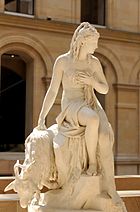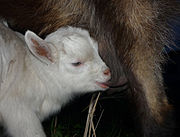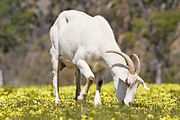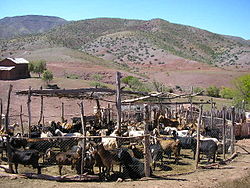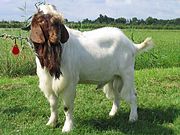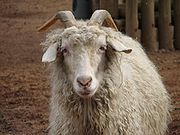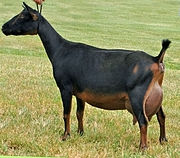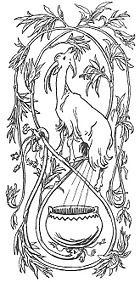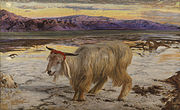
Goat
About this schools Wikipedia selection
SOS Children has tried to make Wikipedia content more accessible by this schools selection. With SOS Children you can choose to sponsor children in over a hundred countries
| Domestic Goat | |
|---|---|
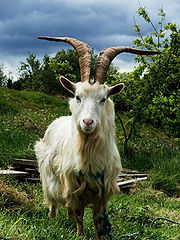 |
|
| Conservation status | |
|
Domesticated
|
|
| Scientific classification | |
| Kingdom: | Animalia |
| Phylum: | Chordata |
| Class: | Mammalia |
| Order: | Artiodactyla |
| Family: | Bovidae |
| Subfamily: | Caprinae |
| Genus: | Capra |
| Species: | C. aegagrus |
| Subspecies: | C. a. hircus |
| Trinomial name | |
| Capra aegagrus hircus (Linnaeus, 1758) |
|
| Synonyms | |
|
|
|
The domestic goat (Capra aegagrus hircus) is a subspecies of goat domesticated from the wild goat of southwest Asia and Eastern Europe. The goat is a member of the Bovidae family and is closely related to the sheep as both are in the goat-antelope subfamily Caprinae. There are over three hundred distinct breeds of goat.
Goats are one of the oldest domesticated species. Goats have been used for their milk, meat, hair, and skins over much of the world. In the twentieth century they also gained in popularity as pets.
Female goats are referred to as does or nannies, intact males as bucks or billies; their offspring are kids. Note that many goat breeders prefer the terms "buck" and "doe" to "billy" and "nanny". Castrated males are wethers. Goat meat from younger animals is called kid or cabrito, and from older animals is sometimes called chevon, or in some areas “ mutton”.
Etymology
The Modern English word goat comes from the Old English gat which meant "she-goat", and this in turn derived from Proto-Germanic *gaitaz (cf. Old Norse and Dutch geit "goat", German Geiß "she-goat", and Gothic gaits "goat"), ultimately from Proto-Indo-European *ghaidos meaning "young goat" but also "jump" (cf. Latin haedus "kid", Old Church Slavonic zajęcǐ "hare", Sanskrit jihīte "he jumps"). To refer to the male of the species, Old English used bucca (which survives as " buck") until a shift to he-goat (and she-goat) occurred in the late 12th century. "Nanny goat" originated in the 18th century and "billy goat" in the 19th.
History
Goats are among the earliest animals domesticated by humans. The most recent genetic analysis confirms the archaeological evidence that the Anatolian Zagros are the likely origin of almost all domestic goats today. Another major genetic source of modern goats is the Bezoar goat; distributed from the mountainous regions of Asia Minor across the Middle East to Sind.
Neolithic farmers began to keep them for easy access to milk and meat, primarily, also for their dung, which was used as fuel and their bones, hair, and sinew for clothing, building, and tools. The earliest remnants of domesticated goats dating 10,000 years before present are found in Ganj Dareh in Iranian Kurdistan. Goat remains have been found at archaeological sites in Jericho, Choga, Mami, Djeitun and Cayonu; dating the domestication of goats in western Asia at between 8000 and 9000 years ago. Domestic goats were generally kept in herds that wandered on hills or other grazing areas, often tended by goatherds who were frequently children or adolescents, similar to the more widely known shepherd. These methods of herding are still used today.
Historically, goat hide has been used for water and wine bottles in both traveling and transporting wine for sale. It has also been used to produce parchment.
Anatomy
Most goats naturally have two horns, of various shapes and sizes depending on the breed. All goats have horns unless they are "polled" meaning they have one parent with a dominant polled gene. There have been incidents of polycerate goats (having as many as eight horns), although this is a genetic rarity thought to be inherited. Their horns are made of living bone surrounded by keratin and other proteins, and are used for defense, dominance, and territoriality.
Goats are ruminants. They have a four-chambered stomach consisting of the rumen, the reticulum, the omasum, and the abomasum.
Goats have horizontal slit-shaped pupils, an adaptation which increases peripheral depth perception. Because goats' irises are usually pale, the pupils are much more visible than in animals with horizontal pupils, but very dark irises, such as cattle, deer, most horses and many sheep.
Both male and female goats have beards, and many types of goat (most commonly dairy goats, dairy-cross boers, and pygmy goats) may have wattles, one dangling from each side of the neck.
Some breeds of sheep and goats look similar, but they can usually be told apart because goat tails are short and point up, whereas sheep tails hang down and are usually longer and bigger – though some (like those of Northern European short-tailed sheep) are short, and longer ones are often docked.
Reproduction
In some climates, goats are able to breed at any time of the year. In temperate climates and among the Swiss breeds, the breeding season commences as the day length shortens, and ends in early spring. Does of any breed come into heat every 21 days for 2 to 48 hours. A doe in heat typically flags her tail often, stays near the buck if one is present, becomes more vocal, and may also show a decrease in appetite and milk production for the duration of the heat.
Bucks (intact males) of Swiss and northern breeds come into rut in the fall as with the doe's heat cycles. Rut is characterized by a decrease in appetite and obsessive interest in the does.
In addition to natural mating, artificial insemination has gained popularity among goat breeders, as it allows easy access to a wide variety of bloodlines.
Gestation length is approximately 150 days. Twins are the usual result, with single and triplet births also common. Less frequent are litters of quadruplet, quintuplet, and even sextuplet kids. Birthing, known as kidding, generally occurs uneventfully. Right before kidding the doe will have a sunken area around the tail and hip. Also she will have heavy breathing, a worried look, become restless and show great display of affection for her keeper. The mother often eats the placenta, which gives her much needed nutrients, helps stanch her bleeding, and parallels the behaviour of wild herbivores such as deer to reduce the lure of the birth scent for predators.
Freshening (coming into milk production) occurs at kidding. Milk production varies with the breed, age, quality, and diet of the doe; dairy goats generally produce between 660 to 1,800 L (1,500 and 4,000 lb) of milk per 305 day lactation. On average, a good quality dairy doe will give at least 6 lb (2.7 l) of milk per day while she is in milk. A first time milker may produce less, or as much as 16 lb (7.3 l), or more of milk in exceptional cases. After the 305 day lactation, the doe will "dry off", typically after she has been bred. Occasionally, goats that have not been bred and are continuously milked will continue lactation beyond the typical 305 days. Meat, fibre, and pet breeds are not usually milked and simply produce enough for the kids until weaning.
Male lactation is also known to occur in goats.
Diet
Goats are reputed to be willing to eat almost anything, except tin cans and cardboard boxes. While goats will not actually eat inedible material, they are browsing animals, not grazers like cattle and sheep, and (coupled with their natural curiosity) will chew on and taste just about anything resembling plant matter in order to decide whether it is good to eat, including cardboard and paper labels from tin cans. Another possibility is that the goats are curious about the unusual smells of leftover food in discarded cans or boxes.
Aside from sampling many things, goats are quite particular in what they actually consume, preferring to browse on the tips of woody shrubs and trees, as well as the occasional broad-leaved plant. However, it can fairly be said that their plant diet is extremely varied, and includes some species which are otherwise toxic. They will seldom consume soiled food or contaminated water unless facing starvation. This is one reason goat rearing is most often free ranging, since stall-fed goat rearing involves extensive upkeep and is seldom commercially viable.
Goats prefer to browse on shrubbery and weeds, more like deer than sheep, preferring them to grasses. Nightshade is poisonous; wilted fruit tree leaves can also kill goats. Silage (corn stalks) is not good for goats, but haylage can be used if consumed immediately after opening. Alfalfa is their favorite hay; fescue is the least palatable and least nutritious. Mold in a goat's feed can make it sick and possibly kill it. Goats should not be fed grass showing any signs of mold.
The digestive physiology of a very young kid (like the young of other ruminants) is essentially the same as that of a monogastric animal. Milk digestion begins in the abomasum, the milk having bypassed the rumen via closure of the reticular/esophageal groove during suckling. At birth, the rumen is undeveloped, but as the kid begins to consume solid feed, the rumen soon increases in size and in its capacity to absorb nutrients.
Behaviour
Goats are extremely curious and intelligent. They are easily trained to pull carts and walk on leads. Ches McCartney, nicknamed "the goat man", toured the United States for over three decades in a wagon pulled by a herd of pet goats. They are also known for escaping their pens. Goats will test fences, either intentionally or simply because they are handy to climb on. If any of the fencing can be spread, pushed over or down, or otherwise be overcome, the goats will escape. Being very intelligent, once a weakness in the fence has been discovered, it will be exploited repeatedly. Goats are very coordinated and can climb and hold their balance in the most precarious places. Goats are also widely known for their ability to climb trees, although the tree generally has to be on somewhat of an angle. The vocalization goats make is called bleating.
Goats have an intensely inquisitive and intelligent nature: they will explore anything new or unfamiliar in their surroundings. They do so primarily with their prehensile upper lip and tongue. This is why they investigate items such as buttons, camera cases or clothing (and many other things besides) by nibbling at them, occasionally even eating them.
Life expectancy
Life expectancy for goats is between 15 and 18 years. An instance of a goat reaching the age of 24 has been reported.
Several factors can reduce this average expectancy, however; problems during kidding can lower a doe's expected life span to 10 or 11, and stresses of going into rut can lower a buck's expected life span to 8 or 10.
Goats in agriculture
A goat is useful to humans either living or dead, first as a renewable provider of milk and fibre, and then as meat and hide. Some charities provide goats to impoverished people in poor countries, because goats are easier and cheaper to manage than cattle, and have multiple uses. In addition, goats are used for driving and packing purposes.
For instance, the intestine is used to make " catgut", which is still in use as a material for internal human surgical sutures and strings for musical instruments. The horn of the goat, which signifies wellbeing ( Cornucopia), is also used to make spoons.
Meat
The taste of goat kid meat is similar to that of spring lamb meat; in fact, in the English-speaking islands of the Caribbean, and in some parts of Asia, particularly Pakistan and India, the word “ mutton” is used to describe both goat and lamb meat. However, some compare the taste of goat meat to veal or venison, depending on the age and condition of the goat. Its flavor is said to be primarily linked to the presence of 4-methyloctanoic and 4-methylnonanoic acid. It can be prepared in a variety of ways including stewed, baked, grilled, barbecued, minced, canned, fried, curried, or made into sausage. Due to its low fat content, the meat can toughen at high temperatures without additional moisture. One of the most popular goats grown for meat is the South African Boer, introduced into the United States in the early 1990s. The New Zealand Kiko is also considered a meat breed, as is the myotonic or "fainting goat", a breed originating in Tennessee.
Milk, butter and cheese
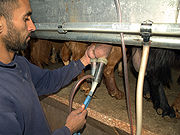
Goats produce approximately 2% of the world's total annual milk supply. Some goats are bred specifically for milk. If the strong-smelling buck is not separated from the does, his scent will affect the milk.
Doe milk naturally has small, well-emulsified fat globules, which means the cream remains suspended in the milk, instead of rising to the top, as in raw cow milk; therefore, it does not need to be homogenized. Indeed, if the milk is going to be used to make cheese it is recommended that it is not homogenized as this changes the structure of the milk impacting the culture's ability to coagulate the milk and the final quality and yield of cheese.
Dairy goats in their prime, which is generally around the third or fourth lactation cycle, average 6 to 8 pounds (2.7 to 3.6 kg) of milk production daily (roughly 3 to 4 US quarts (2.7 to 3.6 liters)) during a ten-month lactation, producing more just after freshening and gradually dropping in production toward the end of their lactation. The milk generally averages 3.5 percent butterfat. A doe may be expected to reach her heaviest production during her third or fourth lactation.
Doe milk is commonly processed into cheese, butter, ice cream, yoghurt, cajeta and other products. Goat cheese is known as chèvre in France, after the French word for "goat". Some varieties include Rocamadour and Montrachet. Goat butter is white because goats produce milk with the yellow beta-carotene converted to a colorless form of vitamin A.
Nutrition
The American Academy of Pediatrics discourages feeding infants milk derived from goats. An April 2010 case report summarizes their recommendation and presents "a comprehensive review of the consequences associated with this dangerous practice," also stating, "Many infants are exclusively fed unmodified goat's milk as a result of cultural beliefs as well as exposure to false online information. Anecdotal reports have described a host of morbidities associated with that practice, including severe electrolyte abnormalities, metabolic acidosis, megaloblastic anaemia, allergic reactions including life-threatening anaphylactic shock, hemolytic uremic syndrome, and infections." Untreated caprine brucellosis results in a 2% case fatality rate. According to the United States Department of Agriculture (USDA), doe milk is not recommended for human infants because it contains "inadequate quantities of iron, folate, vitamins C and D, thiamin, niacin, vitamin B6, and pantothenic acid to meet an infant’s nutritional needs" and may cause harm to an infant's kidneys and could cause metabolic damage.
The Department of Health in the United Kingdom has repeatedly released statements stating on various occasions that "Goats' milk is not suitable for babies, and infant formulas and follow-on formulas based on goats' milk protein have not been approved for use in Europe," and "infant milks based on goats' milk protein are not suitable as a source of nutrition for infants.".
On the other hand, some farming groups promote the practice. For example Small Farm Today in 2005 claimed beneficial use in invalid and convalescent diets, proposing that glycerol ethers, possibly important in nutrition for nursing infants, are much higher in doe milk than in cow milk. A 1970 book on animal breeding claimed that doe milk differs from cow or human milk by having higher digestibility, distinct alkalinity, higher buffering capacity, and certain therapeutic values in human medicine and nutrition. George Mateljan suggested that doe milk can replace ewe milk or cow milk in diets of those who are allergic to certain mammals' milk. However, like cow milk, doe milk has lactose (sugar), and may cause gastrointestinal problems for individuals with lactose intolerance. In fact, the level of lactose is similar to that of bovine milk.
| Constituent | Doe (Goat) | Cow | Human |
|---|---|---|---|
| Fat (g) | 3.8 | 3.6 | 4.0 |
| Protein (g) | 3.5 | 3.3 | 1.2 |
| Lactose (g) | 4.1 | 4.6 | 6.9 |
| Ash (g) | 0.8 | 0.7 | 0.2 |
| Total solids (g) | 12.2 | 12.3 | 12.3 |
| Calories | 70 | 69 | 68 |
| Constituents | unit | Cow | Doe (Goat) |
Ewe (Sheep) |
Water buffalo |
|---|---|---|---|---|---|
| Water | g | 87.8 | 88.9 | 83.0 | 81.1 |
| Protein | g | 3.2 | 3.1 | 5.4 | 4.5 |
| Fat | g | 3.9 | 3.5 | 6.0 | 8.0 |
| Carbohydrate | g | 4.8 | 4.4 | 5.1 | 4.9 |
| Energy | kcal | 66 | 60 | 95 | 110 |
| Energy | kJ | 275 | 253 | 396 | 463 |
| Sugars (lactose) | g | 4.8 | 4.4 | 5.1 | 4.9 |
| Cholesterol | mg | 14 | 10 | 11 | 8 |
| Calcium | IU | 120 | 100 | 170 | 195 |
| Saturated fatty acids | g | 2.4 | 2.3 | 3.8 | 4.2 |
| Monounsaturated fatty acids | g | 1.1 | 0.8 | 1.5 | 1.7 |
| Polyunsaturated fatty acids | g | 0.1 | 0.1 | 0.3 | 0.2 |
These compositions vary by breed, animal, and point in the lactation period.
Fibre
The Angora breed of goats produces long, curling, lustrous locks of mohair. The entire body of the goat is covered with mohair and there are no guard hairs. The locks constantly grow and can be four inches or more in length. Angora crossbreeds, such as the pygora and the nigora, have been created to produce mohair and/or cashgora on a smaller, easier-to-manage animal. The wool is shorn (cut from the body) twice a year, with an average yield of about 10 pounds.
Most goats have softer insulating hairs nearer the skin, and longer guard hairs on the surface. The desirable fibre for the textile industry is the former, and it goes by several names (down, cashmere and pashmina). The coarse guard hairs are of little value as they are too coarse, difficult to spin and difficult to dye. The cashmere goat produces a commercial quantity of cashmere wool, which is one of the most expensive natural fibers commercially produced; cashmere is very fine and soft. The cashmere goat fibre is harvested once a year, yielding around 9 ounces (200 grammes) of down.
In South Asia, cashmere is called " pashmina" (from Persian pashmina, "fine wool"). In the 18th and early 19th century, Kashmir (then called Cashmere by the English), had a thriving industry producing shawls from goat down imported from Tibet and Tartary through Ladakh. The shawls were introduced into Western Europe when the General in Chief of the French campaign in Egypt (1799–1802) sent one to Paris. Since these shawls were produced in the upper Kashmir and Ladakh region, the wool came to be known as "cashmere".
Goat breeds
Goat breeds fall into overlapping, general categories. They are generally distributed in to those used for dairy, fibre, meat, skins, and as companion animals. Some breeds are also particularly noted as pack goats.
Showing
Goat breeders' clubs frequently hold shows, where goats are judged on traits relating to conformation, udder quality, evidence of high production, longevity, build and muscling (meat goats and pet goats) and fiber production and the fiber itself (fibre goats). People who show their goats usually keep registered stock and the offspring of award-winning animals command a higher price. Registered goats, in general, are usually higher-priced if for no other reason than that records have been kept proving their ancestry and the production and other data of their sires, dams, and other ancestors. A registered doe is usually less of a gamble than buying a doe at random (as at an auction or sale barn) because of these records and the reputation of the breeder. Children's clubs such as 4-H also allow goats to be shown. Children's shows often include a showmanship class, where the cleanliness and presentation of both the animal and the exhibitor as well as the handler's ability and skill in handling the goat are scored. In a showmanship class, conformation is irrelevant since this is not what is being judged.
Various "Dairy Goat Scorecards" (milking does) are systems used for judging shows in the US. The American Dairy Goat Association (ADGA) scorecard for an adult doe includes a point system of a hundred total with major categories that include general appearance, the dairy character of a doe (physical traits that aid and increase milk production), body capacity, and specifically for the mammary system. Young stock and bucks are judged by different scorecards which place more emphasis on the other three categories; general appearance, body capacity, and dairy character.
The American Goat Society (AGS) has a similar, but not identical scorecard that is used in their shows. The miniature dairy goats may be judged by either of the two scorecards. The "Angora Goat scorecard" used by the Colored Angora Goat Breeder's Association CAGBA (which covers the white and the colored goats) includes evaluation of an animal's fleece colour, density, uniformity, fineness, and general body confirmation. Disqualifications include: a deformed mouth, broken down pasterns, deformed feet, crooked legs, abnormalities of testicles, missing testicles, more than 3 inch split in scrotum, and close-set or distorted horns.
Religion, mythology, and folklore
According to Norse mythology, the god of thunder, Thor, has a chariot that is pulled by the goats Tanngrisnir and Tanngnjóstr. At night when he sets up camp, Thor eats the meat of the goats, but take care that all bones remain whole. Then he wraps the remains up, and in the morning, the goats always come back to life to pull the chariot. When a farmer's son who is invited to share the meal breaks one of the goats' leg bones to suck the marrow, the animal's leg remains broken in the morning, and the boy is forced to serve Thor as a servant to compensate for the damage.
Possibly related, the Yule Goat is one of the oldest Scandinavian and Northern European Yule and Christmas symbols and traditions. Yule Goat originally denoted the goat that was slaughtered around Yule, but it may also indicate a goat figure made out of straw. It is also used about the custom of going door-to-door singing carols and getting food and drinks in return, often fruit, cakes and sweets. "Going Yule Goat" is similar to the British custom wassailing, both with heathen roots. The Gävle Goat is a giant version of the Yule Goat, erected every year in the Swedish city of Gävle.
The Greek god, Pan, is said to have the upper body of a man and the horns and lower body of a goat. Pan was a very lustful god, nearly all of the myths involving him had to do with him chasing nymphs. He is also credited with creating the pan flute.
The goat is one of the twelve-year cycle of animals which appear in the Chinese zodiac related to the Chinese calendar. Each animal is associated with certain personality traits; those born in a year of the goat are predicted to be shy, introverted, creative, and perfectionist. See Goat (zodiac).
Several mythological hybrid creatures are believed to consist of parts of the goat, including the Chimera. The Capricorn sign in the Western zodiac is usually depicted as a goat with a fish's tail. Fauns and satyrs are mythological creatures that are part goat and part human. The mineral bromine is named from the Greek word "brόmos," which means "stench of he-goats."
Goats are mentioned many times in the Bible. A goat is considered a "clean" animal by Jewish dietary laws and was slaughtered for an honored guest. It was also acceptable for some kinds of sacrifices. Goat-hair curtains were used in the tent that contained the tabernacle ( Exodus 25:4). On Yom Kippur, the festival of the Day of Atonement, two goats were chosen and lots were drawn for them. One was sacrificed and the other allowed to escape into the wilderness, symbolically carrying with it the sins of the community. From this comes the word " scapegoat". A leader or king was sometimes compared to a male goat leading the flock. In the New Testament, Jesus told a parable of The Sheep and the Goats. ( Gospel of Matthew 25)
Popular Christian folk tradition in Europe associated Satan with imagery of goats (see Pan (mythology)). A common superstition in the Middle Ages was that goats whispered lewd sentences in the ears of the saints. The origin of this belief was probably the behaviour of the buck in rut, the very epitome of lust. The common medieval depiction of the Devil was that of a goat-like face with horns and small beard (a goatee). The Black Mass, a probably-mythological "Satanic mass," was said to involve a black goat, the form in which Satan supposedly manifested himself for worship.
The goat has had a lingering connection with Satanism and pagan religions, even into modern times. The inverted pentagram, a symbol used in Satanism, is said to be shaped like a goat's head. The " Baphomet of Mendes" refers to a satanic goat-like figure from 19th century occultism.
Feral goats

Goats readily revert to the wild (become feral) if given the opportunity. The only domestic animal known to return to feral life as swiftly is the cat. Feral goats have established themselves in many areas: they occur in Australia, New Zealand, Great Britain, the Galapagos and in many other places. When feral goats reach large populations in habitats which are not adapted to them, they may have serious effects, such as removing native scrub, trees and other vegetation. Feral goats are common in Australia. However, in other circumstances they may become a natural component of the habitat.
